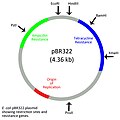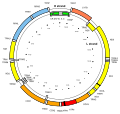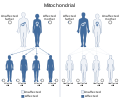Extrachromosomal DNA
Extrachromosomal DNA is a type of DNA that is not located within the chromosomes. Instead, it is found outside of the chromosomes in the cytoplasm or nucleus. This DNA can be found in various forms such as plasmids, mitochondrial DNA, and chloroplast DNA.
Overview[edit]
Extrachromosomal DNA is a significant part of the genetic material in a cell. It is not bound by the same restrictions as chromosomal DNA, allowing it to replicate independently and often at a faster rate. This can lead to an increase in the number of copies of certain genes, which can have various effects on the organism.
Types of Extrachromosomal DNA[edit]
Plasmids[edit]
Plasmids are small, circular pieces of DNA that are found in bacteria and some eukaryotes. They can replicate independently of the chromosomal DNA and can be transferred between cells. Plasmids often carry genes that provide a survival advantage to the organism, such as antibiotic resistance genes.
Mitochondrial DNA[edit]
Mitochondrial DNA (mtDNA) is found in the mitochondria, the energy-producing organelles in the cell. Unlike chromosomal DNA, mtDNA is inherited solely from the mother. Mutations in mtDNA can lead to various diseases, including Leber's hereditary optic neuropathy and mitochondrial myopathy.
Chloroplast DNA[edit]
Chloroplast DNA (cpDNA) is found in the chloroplasts of plants and algae. Like mtDNA, cpDNA is inherited from the mother. It is responsible for photosynthesis and other functions of the chloroplast.
Role in Disease[edit]
Extrachromosomal DNA can play a role in disease. For example, certain cancers have been found to have high levels of extrachromosomal DNA, which can lead to an increase in the number of copies of oncogenes. This can drive the growth and spread of the cancer.
See Also[edit]
Ad. Transform your life with W8MD's Budget GLP-1 injections from $75


W8MD offers a medical weight loss program to lose weight in Philadelphia. Our physician-supervised medical weight loss provides:
- Weight loss injections in NYC (generic and brand names):
- Zepbound / Mounjaro, Wegovy / Ozempic, Saxenda
- Most insurances accepted or discounted self-pay rates. We will obtain insurance prior authorizations if needed.
- Generic GLP1 weight loss injections from $75 for the starting dose.
- Also offer prescription weight loss medications including Phentermine, Qsymia, Diethylpropion, Contrave etc.
NYC weight loss doctor appointmentsNYC weight loss doctor appointments
Start your NYC weight loss journey today at our NYC medical weight loss and Philadelphia medical weight loss clinics.
- Call 718-946-5500 to lose weight in NYC or for medical weight loss in Philadelphia 215-676-2334.
- Tags:NYC medical weight loss, Philadelphia lose weight Zepbound NYC, Budget GLP1 weight loss injections, Wegovy Philadelphia, Wegovy NYC, Philadelphia medical weight loss, Brookly weight loss and Wegovy NYC
|
WikiMD's Wellness Encyclopedia |
| Let Food Be Thy Medicine Medicine Thy Food - Hippocrates |
Medical Disclaimer: WikiMD is not a substitute for professional medical advice. The information on WikiMD is provided as an information resource only, may be incorrect, outdated or misleading, and is not to be used or relied on for any diagnostic or treatment purposes. Please consult your health care provider before making any healthcare decisions or for guidance about a specific medical condition. WikiMD expressly disclaims responsibility, and shall have no liability, for any damages, loss, injury, or liability whatsoever suffered as a result of your reliance on the information contained in this site. By visiting this site you agree to the foregoing terms and conditions, which may from time to time be changed or supplemented by WikiMD. If you do not agree to the foregoing terms and conditions, you should not enter or use this site. See full disclaimer.
Credits:Most images are courtesy of Wikimedia commons, and templates, categories Wikipedia, licensed under CC BY SA or similar.
Translate this page: - East Asian
中文,
日本,
한국어,
South Asian
हिन्दी,
தமிழ்,
తెలుగు,
Urdu,
ಕನ್ನಡ,
Southeast Asian
Indonesian,
Vietnamese,
Thai,
မြန်မာဘာသာ,
বাংলা
European
español,
Deutsch,
français,
Greek,
português do Brasil,
polski,
română,
русский,
Nederlands,
norsk,
svenska,
suomi,
Italian
Middle Eastern & African
عربى,
Turkish,
Persian,
Hebrew,
Afrikaans,
isiZulu,
Kiswahili,
Other
Bulgarian,
Hungarian,
Czech,
Swedish,
മലയാളം,
मराठी,
ਪੰਜਾਬੀ,
ગુજરાતી,
Portuguese,
Ukrainian





